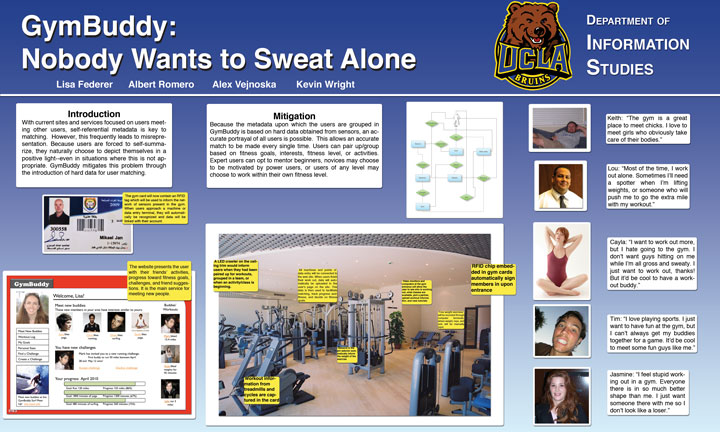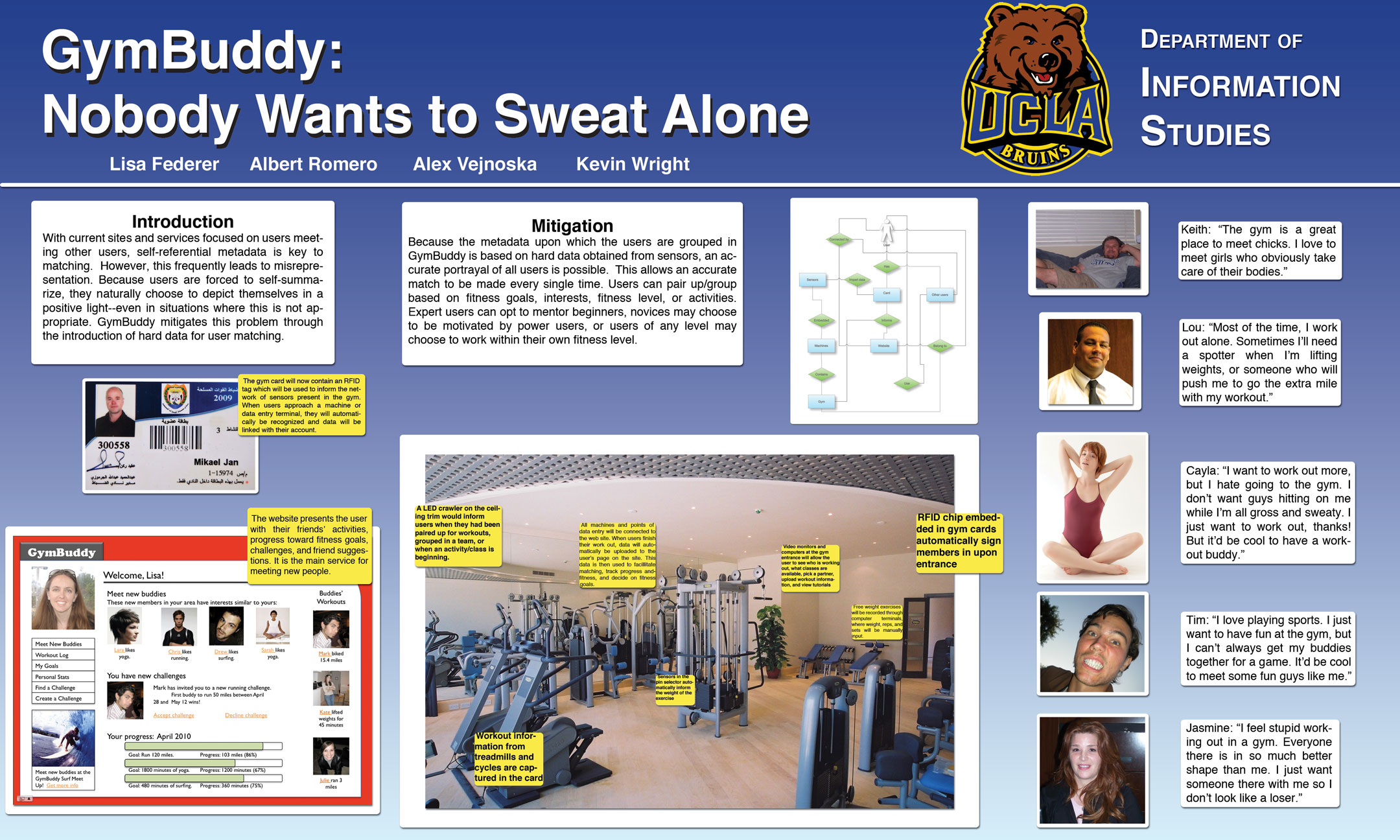GymBuddy
Project Team: Lisa Federer, Albert Romero, Alex Vejnoska, Kevin Wright
(click on image to enlarge)
Abstract:
This poster outlines GymBuddy, a social networking site that connects users with workout partners in their area. The system provides users two services: pairing with other users and storage and organization of workout data.
Categories and Subject Descriptors H.3.4 [Information Storage and Retrieval]: Systems and Software information networks, user profiles and alert services.
General Terms Design, Experimentation, Human Factors.Keywords Social networking, information technology system, integrated sensor network, user pairing.
1. INTRODUCTION
Worldwide, people spend over 500 billion minutes per month on Facebook. The online dating industry is worth $1.05 billion a year, making it more profitable than the pornography industry. Clearly, social networking has become big business. As it turns out, its also a remarkably effective way to meet people. Meeting online is actually more conducive to open and honest communication than meeting in person, since users feel a sense of security in their relative anonymity.
With so many sites connecting millions of users worldwide, it seems as though it should be easy to find a match for friendship, dating, or more. Yet in the world of social networking, quite often people are not who they present themselves to be. Since most metadata on social networking sites is self-created and self-referential, many users fudge the truth or lie outright about who they are. Most of these factitious personal statistics are related to appearance: men are most likely to lie about their age and height, while women lie about their weight, physical build, and age. Unfortunately, the person you end up meeting in person is often not the person you expected from reading his or her online description.
2. THE SOLUTION: GYMBUDDY
In designing our social networking system, we hoped to solve the problem of user misrepresentation and pair users for a specific activity that meets their interests. Our system, GymBuddy, takes social networking to the gym, combining the popularity of meeting people online with the growing trend of the gym as a social space. As gyms add cafes, salons, concierges, and other luxury services, going to the gym is becoming more than just a workout. Its a lifestyle experience and a highly social public space in short, an excellent place to meet new people. Since some gym members prefer to work out alone, GymBuddy is an opt-in system, and the workout experience for members who opt out would be minimally impacted.
The GymBuddy system relies more on hard data about users than self-referential metadata. A network of sensors within the gym and a smart gym card to track users activities helps to ensure users profiles become more accurate. While users may choose to hide certain properties in their profile from the public, the system still bases its matches on hard data originating not from users themselves, but from the systems own network of sensors. GymBuddy also removes some of the planning of a first meeting by pairing people with a specific activity in mind. Users can find other people interested in the activity of their choice and meet up for a workout, thus alleviating some of the anxiety of arranging a first meeting. Pairing users to meet up at the gym also allows users to feel a greater sense of security and safety; rather than arranging to meet a total stranger at a bar or restaurant, GymBuddy users meet in a familiar setting their own gym.
3. SYSTEM OVERVIEW
At the heart of GymBuddy is a network of integrated sensors that are used to inform the web service in order to match users. The capturing of accurate data in each facet of the workout is essential to accurate user matching, so all activities are recorded and reported automatically, in order to prevent any misrepresentation through mistaken or deliberate means.
The gym membership card--a legacy system used to check in members to all gyms--will be retrofitted with an RFID tag that integrating data recording and reporting. Upon entry to the gym, the users card will trigger a sensor in the doorframe, automatically signing them in. When working out at a machine, proximity to the card will immediately recognize the user and store all workout data on the web servers, with which the machines are networked. Free weight activities (and other exercises into which sensors may not be integrated) will be recorded using a terminal where the activity, repetitions, and weight are self-reported by the user. Should the user desire a match using GymBuddy, a computer terminal at the front of the gym may be accessed. At this terminal, a list of people seeking workout partners will be available with suggestions of best matches from the system. Users may search for activities such as pickup sport games or aerobics classes. When a user already working out has been paired, a message on an LED crawler spanning the trim of the gym will alert them where to meet their partner.
After leaving the gym, all the workout data recorded at the machines will be available on the web site for the user to review and share with friends. This data will be used to determine matching between users, as well as assign general expertise levels. Expert users will be able to choose to mentor beginners, novices may choose to be motivated by more experienced users, or any level may choose to work out within their own group.
4. NAVIGATING SOCIAL SPACES
Although many applications already on the market provide similar functionality to runners, cyclists, and weight lifters, the Gym Buddy system facilitates meeting people in the often socially-daunting physical space of the gym. The hard data that is recorded about a users workout program and fitness levels is useful to individual users, but only when it is analyzed and interpreted can it be used in order to match people with similar achievements and goals. It can be used to find activity partners, make friends or initiate romantic encounters, depending upon the intentions of the parties involved. LIS expertise in user-experience design and information-seeking behavior is utilized to give users ultimate levels of comfort and control while using the system. Ultimate control is given to the user, who also decides the level of granularity of control. Socially-encoded aspects of physical meeting locations, such as the cave-and-commons design, have been incorporated into the system. Sensitivity to ongoing and emerging privacy concerns regarding social networking is also heavily considered in the design.
5. INCREASING GYM TRAFFIC
Many of the current systems that track exercise data are limited and outdated, but GymBuddy features components that compete with todays information technological infrastructure. These components include sensors implemented on both membership cards and fitness equipment, and takes advantage of wireless network technology. Since sensors continuously track users fitness activities, they can easily keep track of their workouts with no extra computation. Users may access the system through kiosks in their gym, any web browser, and most mobile devices. A user-friendly app allows users to keep track of progress, check for a friend at the gym, and find a new workout partner.
6. REFERENCES
[1] Facebook Press Room. 2010. Facebook Statistics. URL= http://www.facebook.com/press/info.php?statistics[2] How To Improve Your Health (& Social Life) At The Gym. Ebony 59, 4 (Feb. 2004), 52-54.
[3] Mikyoung, K., Kyoung-Nan, K., and Mira, L. 2009. Psychological Characteristics of Internet Dating Service Users: The Effect of Self-Esteem, Involvement, and Sociability on the Use of Internet Dating Services. CyberPsychology & Behavior 12, 4 (2009): 445-449.
[4] Online Dating Statistics Reveal What Women Lie About Most. Huffiington Post (May 2010). URL= http://www.huffingtonpost.com/2010/03/25/online-dating-statistics_n_511716.html
